


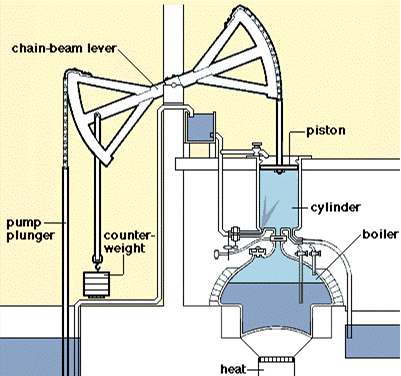
Newcomen's Steam Engine
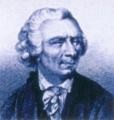 A Diagram of Thomas Newcomen was born in 1663 in the mining town of Dartmouth, Devon, England. Newcomen saw the problem of water-powered machines, namely the fact that they forced factories to be built beside a water source and that floods could occur during certain seasons. So, Newcomen set to work to produce the first successful steam engine in 1712 to pump water from mines. The steam engine consisted of a vacuum within a cylinder used to pull down a piston. A lever was then used to transfer the force to the pump shaft that went down into the mine. In 1714, Newcomen�s steam engines were very expensive were very expensive, but many were produced nonetheless. However, because Thomas Savery�s patent on a pump, which covered all engines that raised water by fire, lasted until 1733, Newcomen was forced to settle on simply going into partnership with Savery. Thus, Newcomen never became wealthy before his death in 1733.
A Diagram of Thomas Newcomen was born in 1663 in the mining town of Dartmouth, Devon, England. Newcomen saw the problem of water-powered machines, namely the fact that they forced factories to be built beside a water source and that floods could occur during certain seasons. So, Newcomen set to work to produce the first successful steam engine in 1712 to pump water from mines. The steam engine consisted of a vacuum within a cylinder used to pull down a piston. A lever was then used to transfer the force to the pump shaft that went down into the mine. In 1714, Newcomen�s steam engines were very expensive were very expensive, but many were produced nonetheless. However, because Thomas Savery�s patent on a pump, which covered all engines that raised water by fire, lasted until 1733, Newcomen was forced to settle on simply going into partnership with Savery. Thus, Newcomen never became wealthy before his death in 1733.
Picture Sources:
Steam Engine: www.unb.ca/web/transpo/mynet/engines.htm
Portrait: http://leifi.physik.uni-muenchen.de/web_ph09/umwelt_technik/08dampfm/newcomen.htm
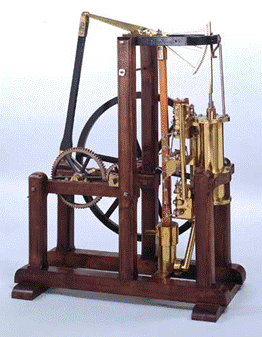
Watt's Steam Engine
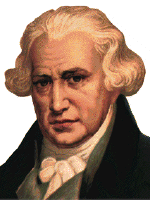 James Watt was born the son of a shipwright in Greenock, Scotland on January 19, 1736. For his early childhood, Watt was mostly educated by his mother, but when she died when James was seventeen, Watt went to London to study instrument-making. He then moved back to Glasgow, Scotland, where Watt opened a small workshop with the University of Glasgow in 1757. Four years after opening his shop, Watt began experimenting unsuccessfully with steam engines. While repairing a Newcomen steam engine, in 1763, Watt gained insights which allowed him to create his first model of the modern steam engine in 1765. With this new steam engine, the steam condensed in a separate chamber apart from the piston, temperature of the cylinder was maintained at the same temperature as the injected steam. In the meantime, Watt married his cousin billy Miller in 1767, with whom he had six children. Watt patented this model in 1769, and in 1776 the first engines were installed and working in commercial enterprises. Meanwhile, Watt continued to make improvements to his steam engine, which he patented in 1881, 1882, and 1884. Wealthy from his inventions, Watt retired in 1800. During his retirement, he traveled to France and Germany with his second wife and he purchased an estate in Wales. He later died in his home �Heathfield� in Handsworth, Staffordshire on August 25, 1819.
James Watt was born the son of a shipwright in Greenock, Scotland on January 19, 1736. For his early childhood, Watt was mostly educated by his mother, but when she died when James was seventeen, Watt went to London to study instrument-making. He then moved back to Glasgow, Scotland, where Watt opened a small workshop with the University of Glasgow in 1757. Four years after opening his shop, Watt began experimenting unsuccessfully with steam engines. While repairing a Newcomen steam engine, in 1763, Watt gained insights which allowed him to create his first model of the modern steam engine in 1765. With this new steam engine, the steam condensed in a separate chamber apart from the piston, temperature of the cylinder was maintained at the same temperature as the injected steam. In the meantime, Watt married his cousin billy Miller in 1767, with whom he had six children. Watt patented this model in 1769, and in 1776 the first engines were installed and working in commercial enterprises. Meanwhile, Watt continued to make improvements to his steam engine, which he patented in 1881, 1882, and 1884. Wealthy from his inventions, Watt retired in 1800. During his retirement, he traveled to France and Germany with his second wife and he purchased an estate in Wales. He later died in his home �Heathfield� in Handsworth, Staffordshire on August 25, 1819.
Picture Sources:
Steam Engine: http://www.glasgowmuseums.com/shop.cfm?itemid=18&Showid=15&slideid=17
Portrait: http://web.ukonline.co.uk/thursday.handleigh/history/power/index.htm
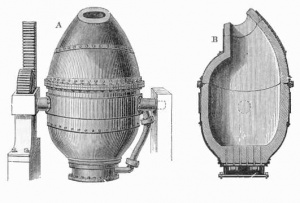
The Bessemer Process
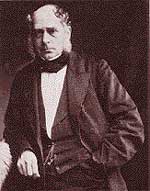 Henry Bessemer was born in Charlton, England, on January 19, 1813. He developed the Bessemer process in the 1850s after buying the process for the process from William Kelly. The Bessemer process was a cheap and efficient method of making steel which involved forcing air through the molten metal to burn out carbon and other impurities that made the chemical brittle. Thus, steel began to be substituted for other materials in the manufacturing of many things. Because of the great improvements he made with his Bessemer process, he was knighted by the Royal Society in 1879 before he died in March 1898 in Denmark Hill, London.
Henry Bessemer was born in Charlton, England, on January 19, 1813. He developed the Bessemer process in the 1850s after buying the process for the process from William Kelly. The Bessemer process was a cheap and efficient method of making steel which involved forcing air through the molten metal to burn out carbon and other impurities that made the chemical brittle. Thus, steel began to be substituted for other materials in the manufacturing of many things. Because of the great improvements he made with his Bessemer process, he was knighted by the Royal Society in 1879 before he died in March 1898 in Denmark Hill, London.
Picture Sources:
Bessemer Process: experts.about.com/e/b/be/Bessemer_process.htm
Portrait: http://www.ohiocitizen.org/campaigns/isg/steelchrono.html
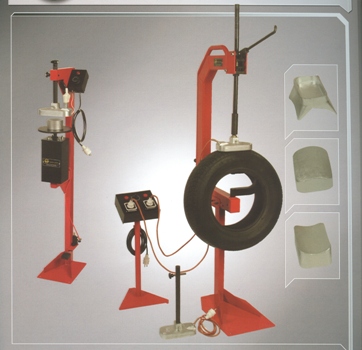
A Modern Machine for Vulcanization
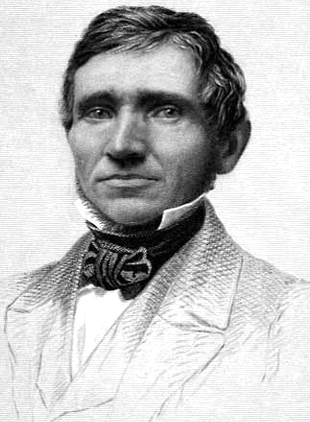 Charles Goodyear was born on December 29, 1800 in New Haven, Connecticut, the son of a farmer who is himself credited with being the first manufacturer of pearl buttons in the U.S. Thus, Charles had the blood of an inventor in him. He moved to Philadelphia at the age of seventeen to work with a firm of importers and manufacturers agents, but returned to Connecticut to become a partner in one of his father�s businesses in 1821. He married in 1824 and, in 1826, went back to Philadelphia where he set up a retail hardware store. However, this business unfortunately failed and Goodyear was imprisoned due to debt. In order to get himself out of debt, Charles turned to inventing, and he soon set out to improve the new rubber which melted in summer and cracked in winter. Despite his state of poverty, Goodyear managed to get enough financial backing for his work and he received a patent for his acid-gas process in 1837. In 1838, Charles purchased the former Eagle India Rubber Company along with Nathaniel Hayward, and together they took out a patent for the combination of rubber with sulfur, which helped rubber hold up in the midst of extreme weather conditions. Goodyear took out the important patent for vulcanization in 1844. He died, probably as a result of his work with white lead in experiments, on July 1, 1860, still in debt despite his great achievement.
Charles Goodyear was born on December 29, 1800 in New Haven, Connecticut, the son of a farmer who is himself credited with being the first manufacturer of pearl buttons in the U.S. Thus, Charles had the blood of an inventor in him. He moved to Philadelphia at the age of seventeen to work with a firm of importers and manufacturers agents, but returned to Connecticut to become a partner in one of his father�s businesses in 1821. He married in 1824 and, in 1826, went back to Philadelphia where he set up a retail hardware store. However, this business unfortunately failed and Goodyear was imprisoned due to debt. In order to get himself out of debt, Charles turned to inventing, and he soon set out to improve the new rubber which melted in summer and cracked in winter. Despite his state of poverty, Goodyear managed to get enough financial backing for his work and he received a patent for his acid-gas process in 1837. In 1838, Charles purchased the former Eagle India Rubber Company along with Nathaniel Hayward, and together they took out a patent for the combination of rubber with sulfur, which helped rubber hold up in the midst of extreme weather conditions. Goodyear took out the important patent for vulcanization in 1844. He died, probably as a result of his work with white lead in experiments, on July 1, 1860, still in debt despite his great achievement.
Picture Sources:
Vulcanization Machine: http://www.turkishsellers.com/searchproduct.aspx?keyword=machine&total=213&page=40
Portrait: users.wfu.edu/jameam5/Serendipity.htm